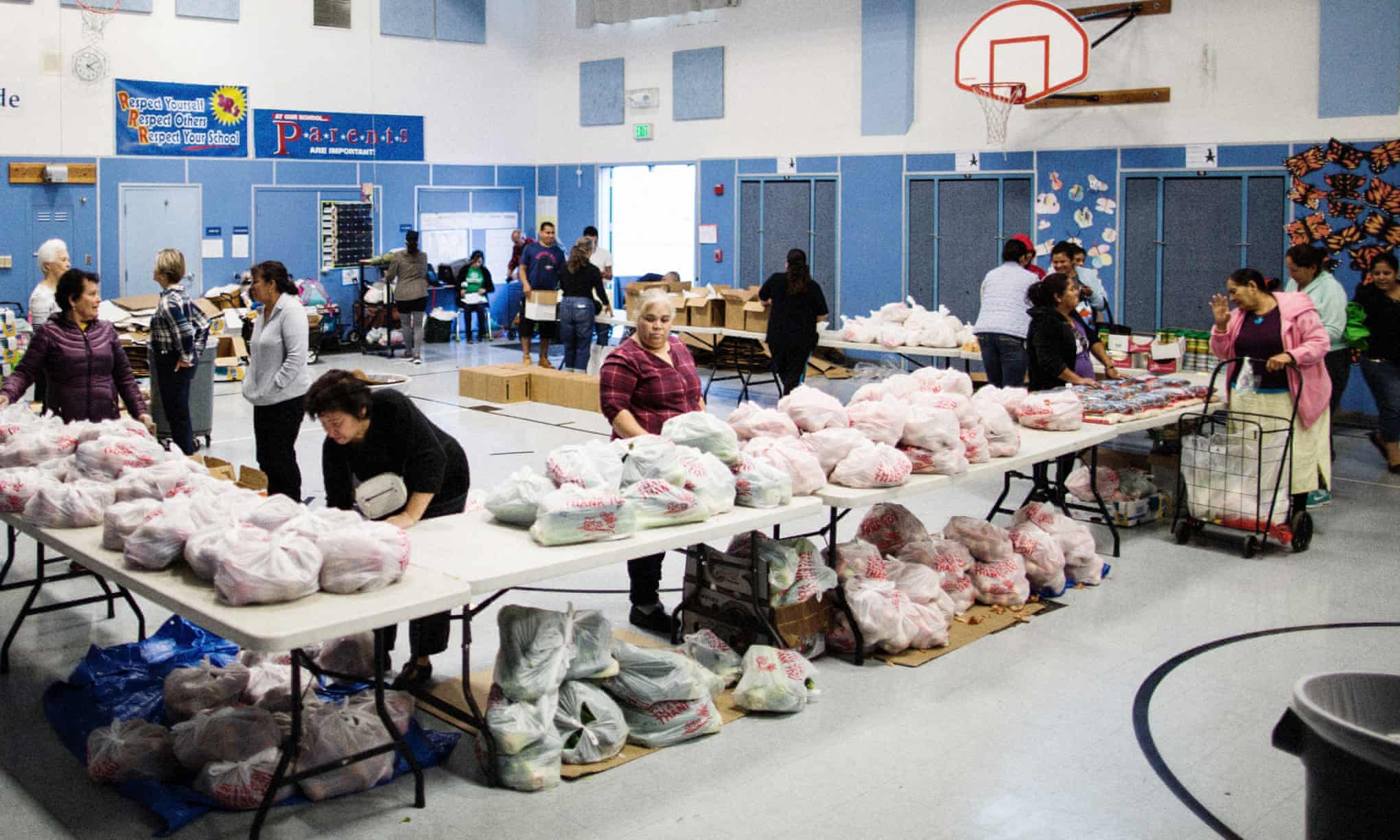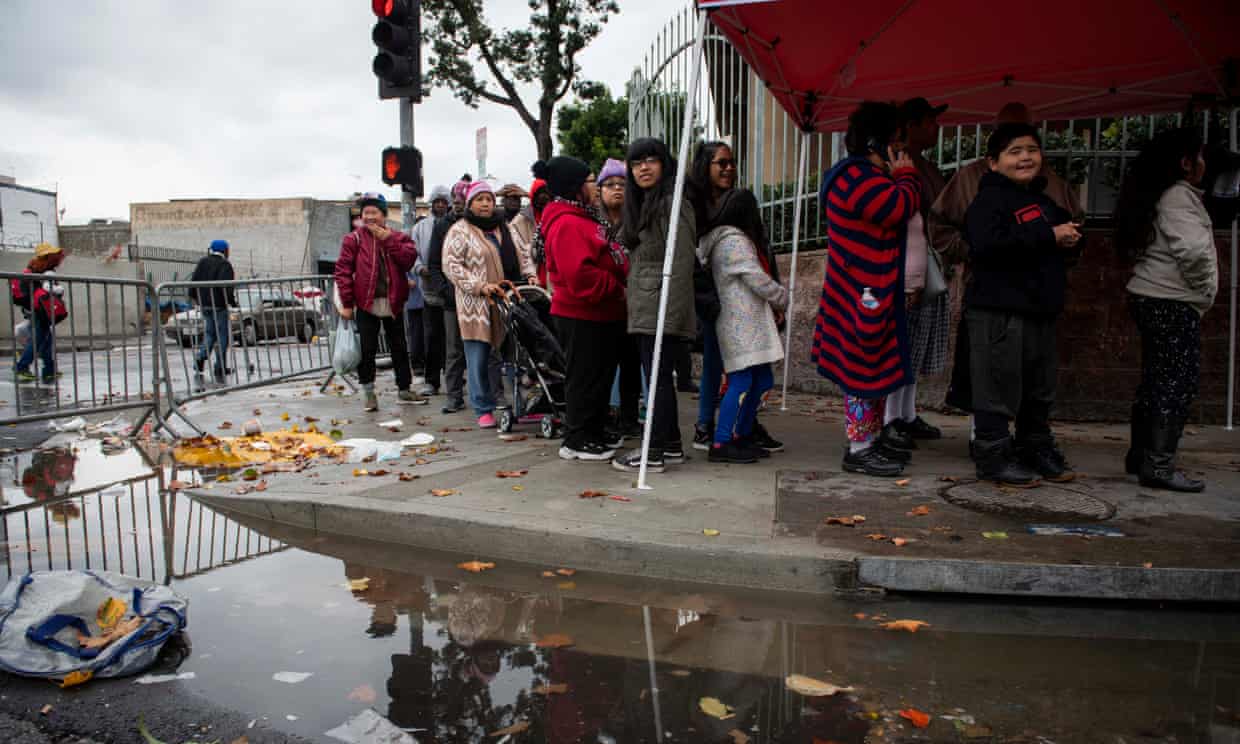
US immigration
'Will they take my kids away?': the immigrants refusing food aid amid Trump crackdown
The administration’s anti-immigrant agenda has made people fearful of accepting help they are legally entitled to
by Mario KoranOn a recent Tuesday morning, Patricia walked into the Salvation Army in Redwood City, a community south of San Francisco, because a friend told her they could help her feed her family without fear of reprisal from US immigration officials.
But Patricia, an undocumented migrant from Guatemala, whose last name the Guardian has agreed to withhold, still had questions.
“Can I still get food stamps even though I don’t have papers?” she asked in Spanish. “If I do, will they take my kids away?”
Vicky Avila Medrano, an outreach worker for Second Harvest Food Bank of Silicon Valley, which distributes food at 1,000 sites across the Bay Area including the Salvation Army, reassured Patricia that accepting food assistance for her US-born children would not invite the scrutiny of immigration officials. “Your children still have a right to food. This is nothing that immigration can hold against you,” she said.
The Trump administration’s relentless anti-immigrant agenda has made a growing number of immigrants like Patricia fearful of accepting assistance and benefits they or their children are legally entitled to.
Their fears are compounded by a US supreme court ruling late last month that allows the administration to expand the “public charge” criteria, which officials have used for more than a century to determine which immigrants were likely to become dependent on the government, and thus ineligible to enter the US or obtain a green card.

“Public charge” has historically been reserved for immigrants receiving cash assistance or who are likely to become institutionalized and dependent on long-term care.
Now, though, immigration officials will consider public benefits, including food stamps, housing vouchers and medical care. Public charge will be applied to anyone who receives one or more public benefits for more than 12 months during the 36-month period.
Because receiving two benefits in one month will count as two months worth of benefits, a relatively small amount of assistance could put people over the threshold. A person’s savings, credit score and ability to speak English will also be considered.
Officials are still required to look at the totality of a person’s circumstances, but advocates say receiving assistance will weigh more heavily against them and result in greater scrutiny of applications.
Policy experts and immigrant rights advocates say the changes will directly apply to a relatively small group of people, primarily those applying for a visa or green card. The changes won’t apply to US citizens, refugees, asylees and other protected groups, as well as those who already have green cards.
But they warn that a much larger chilling effect will ripple through communities, keeping eligible immigrants from seeking assistance for food or medical care to which they, or their children, are duly entitled.
In fact, they say it’s already happening.
After Medrano explained to Patricia that while Patricia is undocumented and not entitled to CalFresh aid, California’s food assistance program, her US-born children are.
What else has she heard about the public charge rule, Medrano wanted to know.
“I heard they’re going to take away your food, take away everything. And you have to pay it back,” Patricia said.
The fears are familiar to Medrano, who has done outreach work for Second Harvest for the past six years.
“This isn’t really new,” Medrano said. “What is new is a president who talks about it in order to scare people.”
‘People are scared’
Medrano estimates that about half of the 20 new clients she speaks with on a typical day ask about the public charge rule.
One woman who arrived at the Salvation Army minutes after Patricia and declined to give her name was a lawful resident. She has two children, but was reluctant to enroll in CalFresh fearing it could affect her application for a green card.
She eventually applied, but had second thoughts. “Now I just wait and hope it doesn’t affect my case,” she said.
Jennery Jazmin Gonzalez Martinez, who works with Medrano as an outreach specialist, said the current political climate has made it more difficult to get people to sign up.
“You try to convince people that it won’t affect them, but they’re so scared that they can’t hear it.” Gonzalez said. Recently, she met a family that planned to disenroll their child from medical benefits out of caution.
Gonzalez and other advocates on the ground attribute much of the confusion to fast-moving changes to an already byzantine system. But they also point to attorneys who, either out of an abundance of caution, or because they themselves don’t understand the rules, have advised clients to drop benefit applications so it doesn’t affect their immigration cases.
Johnathan Garcia, an immigration attorney with Legal Aid Society of San Mateo county, said he often meets people who have been misinformed by attorneys who may not specialize or have proper understanding of immigration law.
“Usually clients don’t approach with a question. It’s more like, ‘I’m afraid, and I’m getting off [public benefits],’” Garcia said.
“It’s been tough to give very clear guidance because we haven’t seen how this is going to be applied. It’s hard to say how this is actually going to impact people until we see it in practice,” Garcia said.
Hungry children
Advocates say the potential impact on families and communities can hardly be overstated in California, home to 3.3 million green card holders, more than anywhere else in the country. More than a quarter of the 9.7 million US citizen children in California have at least one parent who isn’t a citizen.
“California has more immigrants than any other state – and hence much at stake,” reads a brief on the potential impact of the public charge rule, done by the Public Policy Institute of California.
Measurable data showing disenrollment in public benefit programs is hard to come by.
But in nearby Santa Clara county, CalMatters reported, the number of households getting food stamps, in families where at least one members was not a citizen, decreased by 20% from October 2018 – when the proposed rule changes were first announced – to May 2019. Meanwhile food stamp enrollment in citizen households remained consistent.

The news of the new rules stirred concerns among California’s biggest school districts, with school officials from Los Angeles to San Francisco publishing information to help dissuade parents from disenrolling children from the subsidized lunches all low-income students qualify for, regardless of immigration status.
“The policy will make Los Angeles county children hungrier, less healthy and more likely to become homeless,” said Debra Duardo, the Los Angeles county superintendent of schools, in a statement to EdSource.
But Los Angeles Unified, the state’s largest school district, is unable to say whether parental concerns were appearing in data.
A request for public records from Los Angeles Unified on how many families have disenrolled from the free lunch program, as well as how many students may qualify for free lunch but are not receiving it, turned up no information.
“It’s hard to articulate how much of an impact this is having,” said Almas Sayeed, deputy director of programs at the California Immigrant Policy Center, adding that safety systems typically don’t disaggregate data by immigration status.
“Advocates are reluctant to say how many people are disenrolling [from benefits] out of fear it would sort of cement the trend. But [immigrants] are scared. They’re going to disenroll. It’s going to happen,” she said.
Studies of the impacts of 1996 welfare reform may offer clues as to how the new changes will play out.
Drawing from the results of the studies, experts from the UCLA Center for Health Policy Research estimated that 15-35% of immigrants may disenroll from public benefits even when qualified due to confusion and fear.
If the same numbers held true in California, 860,000 recipients of CalFresh, the state’s food stamp program, could be affected by the chilling effect, at a loss to the state of up to $488m in federal funding, depending on how many disenroll.
Even greater would be the impact on the Medi-Cal program, free or low-cost health care coverage for children and families with low income. UCLA’s health policy research team estimates the change could affect 2.1m people, at a loss of up to $1.19bn a year in federal funding.
For Sayeed of the California Immigrant Policy Center, aside from the sweeping impact the reforms may have, at stake is a fundamental question about opportunity and nationhood.
“At the heart of this debate is who belongs and who gets to build and participate in the American dream,” she said.